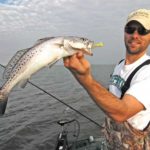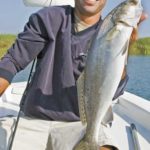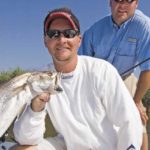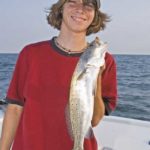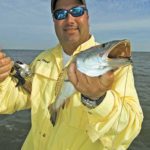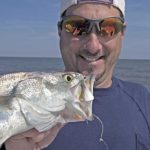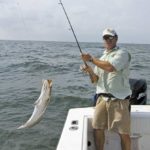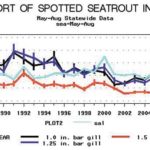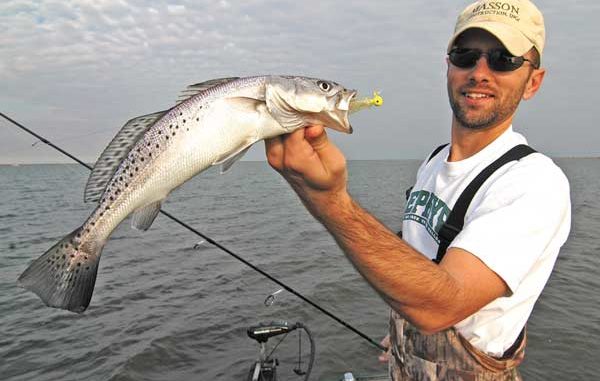
Sampling last year showed a drop in 14-inch trout, but that was compensated by an increase in those fish hovering around the 12-inch mark. That sets up a season of lots of schoolies and fewer big trout, but Gustav and Ike raised questions that will be ans
Hurricanes, with the associated torrential rains and storm surges, didn’t seem to affect the trout fishery last year. And, indeed, the fishing seemed easier in many instances. “It didn’t hurt the fishing any, that’s for sure,” Beachcomber Guide Service’s George Landry said of the waters south of Theriot following Hurricane Gustav. “I think it pushed a lot of fish in closer.”
That lined up with what Department of Wildlife & Fisheries’ Harry Blanchet said in early February. And looking back at what happened the year following Hurricanes Katrina and Rita provides a clue to what might be expected this year.
“Remember what happened?” Blanchet asked. “We had more survival in ’06. People weren’t fishing, so we ended up with more fish.”
National Marine Fisheries Service data show a 2006 jump in harvest from just more than 7.3 million fish in 2005 to more than 13.2 million fish. The total estimated weight of the 2006 harvest was 14.4 million pounds (1.1-pounds-per-fish average), which was up from 7.6 million pounds (1.04-pounds-per-fish average) in 2005.
Total harvest dropped in 2007 to 13.2 million fish, but the average remained at 1.1 pounds per fish.
However, Hurricane Gustav slamming into the coast just south of Houma last year didn’t displace people to the degree of Katrina and Rita. That, along with the fact that boat-access points remained in place, allowed angling to pick up quickly. In addition, the storm surges weren’t as severe as that delivered by the 2005 storms.
Blanchet said that makes comparing Katrina to Gustav a bit like comparing a flats boat to a yacht.
“We wouldn’t expect a bump like we saw after Katrina,” he said. “It didn’t change the salinities (as much). It didn’t change the harvest. It didn’t change a number of factors like those two big storms of ’05.”
However, Blanchet expects trout to be plentiful from what he calls “the hurricane effect.”
“Harvest rates go up,” he said. “Those fish were in the system before the hurricane, but they just become available.”
While the exact reasons for this phenomenon aren’t clear, Blanchet believes there are a couple of factors.
“Salinity generally increases (because of storm surge),” he said. “Some species, like red drum, can be found in relatively fresh waters, but trout are more salinity driven. So when the salinity increases throughout the system, trout are found in more-accessible areas.”
Salinity levels were heightened to a greater degree following Katrina and Rita because of a prolonged drought, but Blanchet said there is generally some impact on the amount of seawater moving into a system when any hurricane makes landfall.
He also said an increase in food availability could be in play.
“Why is it you end up with better shrimp production?” Blanchet asked. “I don’t know, but that may be part of the equation.”
One issue that could have a long-term effect on the fishery is land loss associated with Hurricane Gustav, and also Ike, which sideswiped the state a couple of weeks later.
“Physical condition of a system also has an impact on the fishery,” Blanchet said.
Landry said Gustav definitely ate up some of the marsh below Houma, but added that Ike caused more erosion.
“We saw a lot of (interior) land loss, especially with Ike,” he said. “There was a lot of land that just disappeared.”
Blanchet said the short-term result is an inconvenience for anglers, who might have to relearn some routes through the marsh.
“That point you’re used to might not be there, and if you try to cut the corner, you might end up high and dry,” he said.
It’s the long-term impact, however, that worries managers.
“The marshes are your nurseries,” Blanchet said. “If something isn’t done, we’ll eventually lose the nursery for the fishery.”
That said, erosion wasn’t as serious as many expected.
“It wasn’t extremely bad,” Landry said. “It seemed like (the water) came up slower and went out slower, so it wasn’t like a direct hit from the storm.”
Landry believes that this slow rise and fall of the storm surge protected many vulnerable islands and points that could have been ripped apart by particularly strong water flow.
Even with the loss of land, which has become a standard occurrence during hurricanes, Landry said the fishing remained strong through February.
“Right now, we’re catching limits of trout daily, when the weather allows,” he said in February.
And Blanchet expects that to be the case as the season really kicks in as temperatures warm and trout move into spawning mode.
“May through August is the core of the fishing season and spawn,” Blanchet said.
He said anglers’ best bet is to fish the conditions, looking for waters in which salinities are high because that’s where trout will congregate to propagate.
“When trout are spawning, they will focus on salinities of 15 parts per thousand and above,” Blanchet explained. “About that salinity is when trout eggs are buoyant.”
That’s important because, unlike bass whose eggs lay on the bottom, trout eggs must float to survive.
Location of sufficiently salty waters can vary depending upon how much fresh water flows into the marshes. Local rainfall can impact this factor, but the state’s rivers have much more influence.
“In ’08, we had a river that came up and stayed up and stayed up late,” Blanchet said of the Mississippi. “The Bonnet Carre Spillway was opened last year. You also had a lot of rainfall, so rivers like the Tchefuncte (on the north shore of Lake Pontchartrain) were at or above flood stage up into the summer.
“That affects the availability of trout.”
Exactly what will happen in the rivers leading into this season was still unclear in March.
“If we have one of those cold, wet springs, we’re not only going to have higher rivers in the Mississippi and Atchafalaya, we’re also going to have higher rivers throughout the state,” Blanchet said. “That’s when the real challenge comes in — finding those right conditions for the trout.”
Do the trout disappear? Obviously not, but Blanchet said freshwater inflow can push fish out into major bays and other open waters.
“The fish can scatter out more,” he said. “They will find the salinities they need.”
That’s likely to be an issue this season in those areas influenced by the Mississippi and Atchafalaya rivers, Blanchet anticipated.
“There’s been a lot of snow up north,” he said. “All of that melt has to come through the river.”
The good thing is that, even if rivers like the Mississippi and the Atchafalaya shoot up this spring, they usually have fallen to lower stages again by June.
“That still leaves a lot of fishing time during the summer,” Blanchet said.
